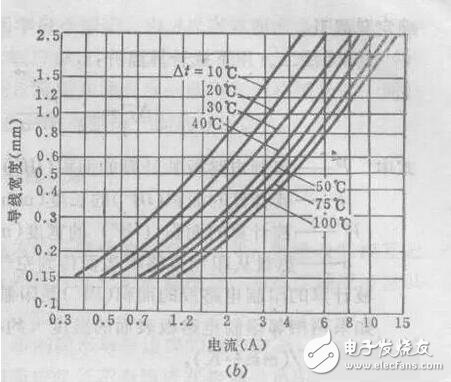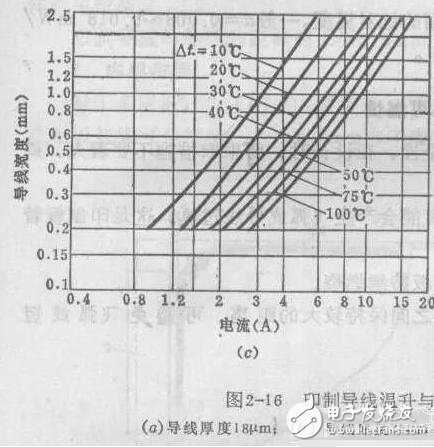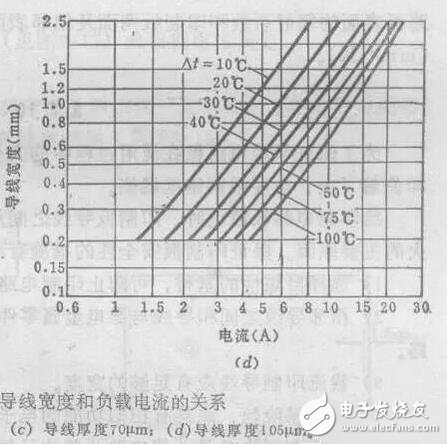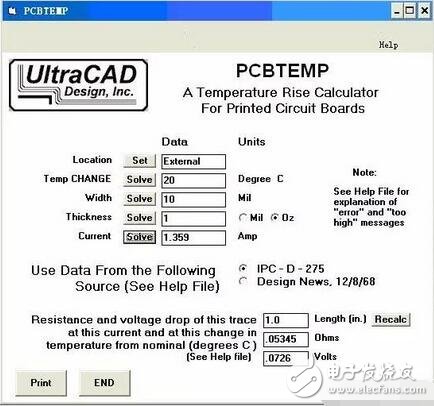Relationship between line width and copper-platinum thickness and current in PCB design
The following summarizes the relationship between the eight currents and line widths on the Internet. The tables and calculation formulas are different (substantially similar), but you can consider the size of the PCB board and the current through the actual PCB board design. A suitable line width.
First, PCB current and line widthThe calculation of PCB current carrying capacity has always lacked authoritative technical methods and formulas. Experienced CAD engineers can make more accurate judgments based on personal experience. But for newcomers to CAD, it is not a difficult problem.
The current carrying capacity of the PCB depends on the following factors: line width, line thickness (copper foil thickness), allowable temperature rise. As we all know, the wider the PCB trace, the greater the current carrying capacity. Assuming that under the same conditions, the 10MIL trace can withstand 1A, then how much current can the 50MIL trace withstand, is it 5A? The answer is naturally no. Please see the following data from international authorities:
Data provided:
The unit of line width is: Inch (1inch = 2.54cm = 25.4mm)
Source: MIL-STD-275 Printed Wiring for Electronic Equipment
Second, PCB design copper and platinum thickness, line width and current relationshipBefore we understand the PCB design's copper-platinum thickness, linewidth, and current relationship, let's take a look at the conversion between the thickness of the PCB copper, in inches and millimeters: "In many data sheets, the copper thickness of the PCB is often ounced. To do the unit, its conversion relationship with inches and millimeters is as follows:
1 ounce = 0.0014 inches = 0.0356 mm (mm)
2 ounces = 0.0028 inches = 0.0712 mm (mm)
Ounce is the unit of weight, which can be converted to millimeters because the copper thickness of the pcb is ounces per square inch."
PCB design copper and platinum thickness, line width and current relationship table

It can also be calculated using the empirical formula: 0.15 & TImes; line width (W) = A
The above data are line current carrying values ​​at a temperature of 25 °C.
Wire impedance: 0.0005 & TImes; L / W (line length / line width)
Current carrying value is directly related to the number of components on the line / pads and vias
In addition, the relationship between the current carrying value of the wire and the number of vias of the wire
The direct relationship between the current carrying value of the wire and the number of vias of the wire (the current formula for calculating the influence of the pad and via hole per square millimeter on the load value of the line is not found, and friends who are interested can find it by themselves. Individuals are not too clear, not explained.) Here are just a few of the main factors that affect the current carrying capacity of the line.
1. The carrying value listed in the tabular data is the maximum current carrying capacity at room temperature of 25 degrees. Therefore, various environments, manufacturing processes, sheet metal processes, sheet quality, etc. should be considered in the actual design. Factors. So the form is provided as a reference value only.
2. In the actual design, each wire will also be affected by the pads and vias. For example, after the tin is over, the current carrying value of the pad will be greatly increased. Many people have seen some lines in the high current board between the pad and the pad being burnt. The reason is very simple. Because the solder is strengthened after the tin is finished, the component current and the solder enhance the current of the wire. The value of the load, and the maximum current carrying value of the pad between the pad and the pad is the maximum current carrying value allowed for the wire width. Therefore, when the circuit fluctuates instantaneously, it is easy to blow off the section between the pad and the pad. Solution: Increase the width of the wire. If the board cannot allow the wire width to be increased, add a layer of the Solder layer to the wire (generally 1 mm). You can add a 0.6-degree Solder layer wire to the wire. Of course, you also add a 1mm Solder layer wire. This way, after 1 tin, the 1mm wire can be seen as a 1.5mm~2mm wire. The uniformity of tin and the amount of tin in tin), as shown below:

Such a treatment method is no stranger to those who are engaged in PCB layout of small household appliances. Therefore, if the amount of tin is enough and the amount of tin is enough, this 1mm wire can be seen not only as a 2mm wire. This is important in single-sided high current boards.
3. The processing method around the pad in the figure is also to increase the uniformity of the current carrying capacity of the wire and the pad. This is especially the case in the board with high current and thick pins (pins greater than 1.2, pads above 3). Very important. Because if the pad is more than 1.2mm above 3mm, it will increase the current of the pad by several tens of times after tinning. If the current fluctuates greatly at high current, the whole line current The load carrying capacity will be very uneven (especially when there are many pads), and it is still easy to cause the possibility of the line between the pad and the pad being blown. The process as shown in the figure can effectively disperse the uniformity of the current carrying value of a single pad and the surrounding line.
Finally, the current carrying value data table is only an absolute reference value. When the high current design is not used, the 10% increase according to the data provided in the table can definitely meet the design requirements. In the general single-panel design, the copper thickness is 35um, which can be basically designed in a ratio of 1 to 1. That is, the current of 1A can be designed with 1mm wire, which can meet the requirements (calculated at 105 degrees). .
Third, the relationship between copper foil thickness, trace width and current during PCB designThe current strength of the signal. When the average current of the signal is large, the current that the wiring width can carry should be considered. For the line width, refer to the following data:
Copper foil thickness, trace width and current relationship during PCB design
The current carrying capacity of copper foils of different thicknesses and widths is shown in the following table:

Note:
i. When copper wire is used as a wire to pass a large current, the current carrying capacity of the width of the copper foil should be considered by considering the value derating of 50% in the table.
Ii. In the PCB design process, OZ (ounces) is commonly used as the unit of copper thickness. 1 OZ copper thickness is defined as the weight of copper foil within 1 square foot. The corresponding physical thickness is 35um; 2OZ copper thickness It is 70um.
Excerpt from: Huawei PCB wiring specification internal information P10
Fourth, how to determine the line width of the high current wire



Fill in the LocaTIon (External/Internal) wire on the surface or inside the FR-4 plate, Temp temperature (Degree C), Width line width (Mil), Thickness thickness (Oz/Mil), then click Solve to find the pass. The current can also be known by the current passed and the line width. Very convenient.

It can be seen that the result of the first method is similar (20 degrees Celsius, 10 mil line width, that is, 0.010 inch line width, copper foil thickness is 1 Oz)
Six empirical formulaI=KT0.44A0.75
(K is the correction factor. Generally, the copper wire is taken as 0.024 in the inner layer and 0.048 in the outer layer.
T is the maximum temperature rise in degrees Celsius (the melting point of copper is 1060 ° C)
A is the copper cross-sectional area in square MIL (not mm mm, note square mil.)
I is the maximum allowable current in amps
Generally 10mil=0.010inch=0.254 can be 1A, 250MIL=6.35mm, 8.3A
Seven, the calculation method provided by a netizen is as followsFirst calculate the cross-sectional area of ​​the track. The thickness of the copper foil of most pcbs is 35um (you can ask the pcb manufacturer if you are not sure). It is the cross-sectional area when you multiply the line width. Note that it is converted into square millimeters. There is an empirical value of current density of 15 to 25 amps per square millimeter. By calling it the cross-sectional area, the flow capacity is obtained.
Eight, a little experience about line width and copper platingWe generally have a common sense when drawing PCBs, that is, thick wires (such as 50 mil or even above) where large currents are used, and thin wires (such as 10 mils) for small current signals. For some electromechanical control systems, sometimes the instantaneous current flowing through the line can reach more than 100A, so that a thinner line will definitely cause problems.
A basic empirical value is: 10A/mm2, that is, a current with a cross-sectional area of ​​1 mm2 can safely pass a current value of 10A. If the line width is too thin, the trace will burn out when a large current passes. Of course, the current burned trace also follows the energy formula: Q = I * I * t, for example, for a trace with 10A current, a 100A current glitch suddenly appears, the duration is us level, then the 30mil wire is Definitely able to withstand. (At this point, another problem arises?? The stray inductance of the wire, this glitch will produce a strong back electromotive force under the action of this inductor, which may damage other devices. The thinner and longer the wire is spur The larger the inductance, the actual length of the wire should be considered.)
General PCB drawing software often has several options for copper via-hole pads on device pins: right-angle spokes, 45-degree spokes, and straight. What is the difference between them? Novices often don't care too much, just pick one and look good. actually not. There are two main considerations: one is to consider not being able to dissipate heat too quickly, and the other is to consider overcurrent capability.
The use of a straight-through method is characterized by a strong overcurrent capability of the pad, which must be used for device pins on high-power loops. At the same time, its thermal conductivity is also very strong. Although it works well for heat dissipation of the device, it is a problem for the board soldering personnel. Because the solder is too fast to dissipate the solder, it is often necessary to use a larger wattage soldering iron and Higher welding temperatures reduce production efficiency. The use of right-angle spokes and 45-angle spokes reduces the contact area between the pins and the copper foil. The heat dissipation is slow and the soldering is much easier. Therefore, the connection method for selecting the copper pad of the via pad should be considered according to the application, the integrated overcurrent capability and the heat dissipation capability. The low power signal line should not be used for straight wiring, but for the high current pad, it must be straight. shop. As for the right angle or the 45 degree angle, it looks beautiful.
Why did you mention this? Because I have been researching a motor driver for a while ago, the device of the H-bridge in this driver is always burned, and I can't find the reason for four or five years. After some hard work, I finally found out that the pad of a device in the power loop was copper-plated using right-angle spokes when copper was used (and because of the poor copper plating, only two spokes actually appeared). This makes the overcurrent capability of the entire power circuit greatly compromised. Although the product has no problems during normal use, it works perfectly at 10A current. However, when the H-bridge is short-circuited, a current of about 100A will appear on the loop, and the two spokes will be blown instantaneously (uS level). Then, the power loop becomes an open circuit, and the energy stored on the motor is dissipated through all possible ways without the discharge channel. This energy will burn the current-sense resistor and related op amp devices and destroy the bridge control chip. It also breaks into the signal and power supply of the digital circuit, causing serious damage to the entire device. The whole process is as thrilling as a hairline detonating a big mine.
So why are there only two spokes on the pads in the power loop? Why not let the copper foil straight up? Because the person in the production department said that this pin is too difficult to solder! The designer just listened to the words of the production staff, so only. . .
KNB2-63 Miniature Circuit Breaker
KNB2-63 Mini Circuit breakers, also named as the air switch which have a short for arc extinguishing device. It is a switch role, and also is a automatic protection of low-voltage electrical distribution. Its role is equivalent to the combination of switch. Fuse. Thermal Relay and other electrical components. It mainly used for short circuit and overload protection. Generally, According to the poles, mini Circuit breaker can be divided into 1P , 1P+N , 2P, 3P and 4P.
KNB2-63 Miniature Circuit Breaker,Electronics Miniature Circuits Breaker,Automatic Miniature Circuit Breaker,Mini Circuit Breaker
Wenzhou Korlen Electric Appliances Co., Ltd. , https://www.zjmannualmotorstarter.com